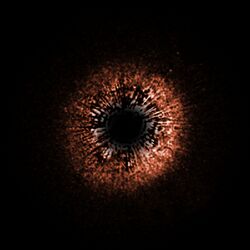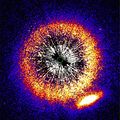Astronomy:HD 107146
| Observation data Equinox J2000.0]] (ICRS) | |
|---|---|
| Constellation | Coma Berenices |
| Right ascension | 12h 19m 06.50230s[1] |
| Declination | 16° 32′ 53.8628″[1] |
| Apparent magnitude (V) | 7.028[2] |
| Characteristics | |
| Spectral type | G2V[3] |
| U−B color index | +0.073[2] |
| B−V color index | +0.602[2] |
| Astrometry | |
| Radial velocity (Rv) | 1.88[4] km/s |
| Proper motion (μ) | RA: -174.684[5] mas/yr Dec.: -149.0214[5] mas/yr |
| Parallax (π) | 36.4038 ± 0.0230[5] mas |
| Distance | 89.59 ± 0.06 ly (27.47 ± 0.02 pc) |
| Details | |
| Mass | 1.09[6] M☉ |
| Radius | 0.993±0.014[6] R☉ |
| Luminosity | 1.1[7] L☉ |
| Surface gravity (log g) | 4.56[8] cgs |
| Temperature | 5850[6] K |
| Metallicity [Fe/H] | 0.00[8] dex |
| Rotation | 3.50±1.35 days[6] |
| Age | 80–200 myr[9] years |
| Other designations | |
| Database references | |
| SIMBAD | data |
HD 107146 is a star in the constellation Coma Berenices that is located about 90 light-years (28 pc) from Earth.[9] The apparent magnitude of 7.028 makes this star too faint to be seen with the unaided eye.
The physical properties of this star are similar to the Sun, including the stellar classification G2V,[3] making this a solar analog.[10] The mass of this star is about 109% of the solar mass (M☉) and it has about 99% the radius of the Sun (R☉).[6] It is a young star with an age between 80 and 200 Myr.[9] The axis of rotation is estimated at 21+8
−9 degrees to the line of sight and it completes a rotation in a relatively brief 3.5 days.[6]
Circumstellar disc
In 2003, astronomers recognized the excess infrared[11] and submillimeter[9] emission indicative of circumstellar dust, the first time such a debris disk phenomenon was noted around a star of similar spectral types to the Sun, though having a much younger age. In 2004 the Hubble Space Telescope detected the presence of a spatially resolved disk surrounding the star.[7][12]
The star's circumstellar disc has dimensions of approximately 210 × 300 AU.[9] The dusty ring is cool, with a temperature of 51 K (−222 °C; −368 °F), and has a dust mass of 0.250±0.004 M⊕ and nearly no gas.[13] Analysis of the debris disk in the far-infrared and submillimeter wavelengths, carried out using the Hubble Space Telescope, suggests the presence of small grains in the disk.[7] The disk appears to be slightly elongated to form an ellipse with its minor axis at a position angle of 58° ± 5°; working under the assumption that the disk is in fact circular gives it an inclination of 25° ± 5° from the plane of the sky.[7] An analysis published in 2009 suggests the possible presence of a planet at a separation of 45-75 AU,[10] in the wide gap centered at 75.4 AU[13] which may be carved by the planet, but no planet with mass exceeding 1-2 MJ was observed in the gap.[14]
| Companion (in order from star) |
Mass | Semimajor axis (AU) |
Orbital period (days) |
Eccentricity | Inclination | Radius |
|---|---|---|---|---|---|---|
| Debris disk | 46.6–135.6 AU | 19.3±1.0° | — | |||
Gallery
Transit of Vermin Galaxy behind HD 107146.[15]
References
- ↑ 1.0 1.1 van Leeuwen, F. (November 2007). "Validation of the new Hipparcos reduction". Astronomy and Astrophysics 474 (2): 653–664. doi:10.1051/0004-6361:20078357. Bibcode: 2007A&A...474..653V.
- ↑ 2.0 2.1 2.2 Landolt, A. U. (June 1983), "UBVRI photometry of stars useful for checking equipment orientation stability", Astronomical Journal 88: 853–866, doi:10.1086/113372, Bibcode: 1983AJ.....88..853L
- ↑ 3.0 3.1 3.2 "HD 107146". SIMBAD. Centre de Données astronomiques de Strasbourg. http://simbad.u-strasbg.fr/simbad/sim-id?Ident=HD+107146.
- ↑ White, Russel J. et al. (June 2007), "High-dispersion optical spectra of nearby stars younger than the Sun", The Astronomical Journal 133 (6): 2524–2536, doi:10.1086/514336, Bibcode: 2007AJ....133.2524W
- ↑ 5.0 5.1 5.2 Brown, A. G. A. (2021). "Gaia Early Data Release 3: Summary of the contents and survey properties". Astronomy & Astrophysics 649: A1. doi:10.1051/0004-6361/202039657. Bibcode: 2021A&A...649A...1G. Gaia EDR3 record for this source at VizieR.
- ↑ 6.0 6.1 6.2 6.3 6.4 6.5 Watson, C. A. et al. (May 2011). "On the alignment of debris discs and their host stars' rotation axis - implications for spin-orbit misalignment in exoplanetary systems". Monthly Notices of the Royal Astronomical Society: Letters 413 (1): L71–L75. doi:10.1111/j.1745-3933.2011.01036.x. Bibcode: 2011MNRAS.413L..71W.
- ↑ 7.0 7.1 7.2 7.3 Ardila, D. R. et al. (2004). "A resolved debris disk around the G2 V star HD 107146". The Astrophysical Journal Letters 617 (2): L147–L150. doi:10.1086/427434. Bibcode: 2004ApJ...617L.147A.
- ↑ 8.0 8.1 Brugamyer, Erik et al. (September 2011). "Silicon and Oxygen Abundances in Planet-host Stars". The Astrophysical Journal 738 (1): 97. doi:10.1088/0004-637X/738/1/97. Bibcode: 2011ApJ...738...97B.
- ↑ 9.0 9.1 9.2 9.3 9.4 Williams, Jonathan P. et al. (March 2004). "Detection of cool dust around the G2 V star HD 107146". The Astrophysical Journal 604 (1): 414–419. doi:10.1086/381721. Bibcode: 2004ApJ...604..414W.
- ↑ 10.0 10.1 Corder, S. A. et al. (2009). "A resolved ring of debris dust around the solar analog HD 107146". The Astrophysical Journal 690 (1): L65–L68. doi:10.1088/0004-637X/690/1/L65. Bibcode: 2009ApJ...690L..65C.
- ↑ Metchev, Stanimir A.; Hillenbrand, Lynne A.; Meyer, Michael R. (January 2004). "Ten micron observations of nearby young stars". The Astrophysical Journal 600 (1): 435–450. doi:10.1086/379788. Bibcode: 2004ApJ...600..435M.
- ↑ "Spitzer and Hubble capture evolving planetary systems". hubblesite.org. December 9, 2004. http://hubblesite.org/newscenter/archive/releases/2004/33/text/.
- ↑ 13.0 13.1 13.2 Marino, S.; Carpenter, J.; Wyatt, M. C.; Booth, M.; Casassus, S.; Faramaz, V.; Guzman, V.; Hughes, A. M. et al. (2018), "A gap in the planetesimal disc around HD 107146 and asymmetric warm dust emission revealed by ALMA", Monthly Notices of the Royal Astronomical Society 479 (4): 5423–5439, doi:10.1093/mnras/sty1790
- ↑
- ↑ "Viewing the Vermin Galaxy". https://www.spacetelescope.org/images/potw1722a/.
 |



